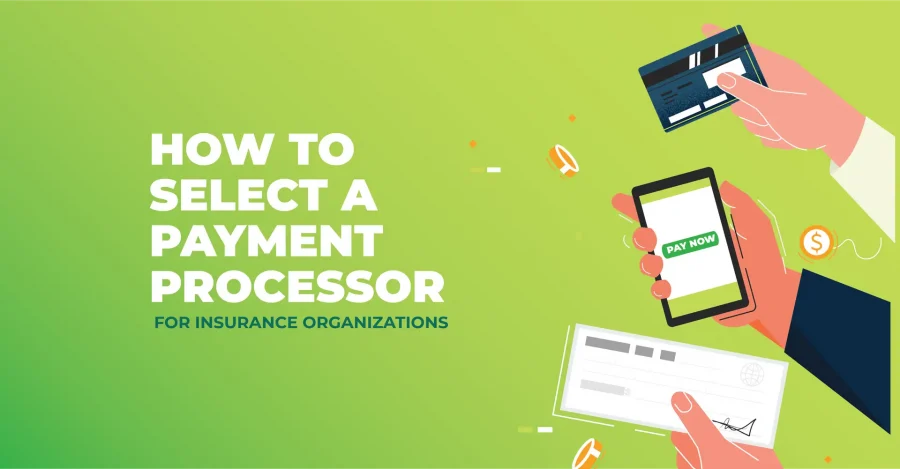Choosing the right insurance payment processing solution is a critical decision for agencies and carriers alike. It affects everything from operational efficiency and compliance to customer satisfaction and cash flow.
Rather than settling for a generic solution, insurance companies should look for payment processing systems designed specifically for the insurance industry. Choose an insurance payment processor by considering how it handles regulations and integrations while accounting for cost and the quality of service. In this step-by-step guide, we’ll delve deeper into how to choose a payment processor that fits your agency’s specific needs and sets your team up for success.
1. Identify Your Needs and Match to Payment Processing System Features
The first step in choosing a payment processing integration is to define the features that you need. Not all payment integrations do the same thing, and not all are built for insurance. Look for payment processor must-haves including:
- Specialized support for your workflows
- Tailored offerings that meet the regulations of the insurance industry
- Optimized processes that reduce manual labor
Based on your needs, evaluate processor options. During the research phase, ask key questions such as:
- What does this integration actually do—and not do?
- Which agency management systems is it compatible with?
- What functionality is specific to insurance workflows?
Bonus Tip: Choose a processor that clearly documents its capabilities and limitations so you can avoid surprises down the road.
2. Choose a Payment Processing Solution That Meets Compliance Standards
Fulfilling compliance requirements is mandatory, so ensure the payment processor you choose is built to meet the standards of the insurance industry.
PCI DSS Regulations
Payment Card Industry Data Security Standard (PCI DSS) compliance is non-negotiable when it comes to handling sensitive financial information. Insurance companies must prioritize payment processors that adhere to PCI standards because:
- It ensures your payment processor follows industry-standard security protocols.
- It protects your agency—and your insureds—from data breaches.
- It builds customer trust by safeguarding the confidentiality and integrity of their payment information.
State-Based Insurance Regulations
Each state has its own set of regulations for selling insurance, meaning the requirements in Ohio may be different from those in New York, California, or Florida. These differences make state-level alignment essential for any payment processor serving the insurance industry.
However, the big global payment processing solution companies are not operating at this micro (state regulations) level. That’s why state-level associations such as Trusted Choice/Big I are valuable—they keep you on track to maintain compliance with any and all state-specific mandates. Pick a processor affiliated with associations like these.
At ePayPolicy, we maintain close relationships with the Big I / Trusted Choice state insurance associations nationwide and are in the process of getting endorsements from all 50 states. Their stamp of approval is their way of saying, “This vendor gets it. We trust them. You should, too.”
3. Look for Processors That Integrate With Your Management Systems
Digital payment processing for insurance companies should make your life easy, and a smooth integration process should make it even easier. Ideally, this means the integration should be seamless with your agency management system. ePayPolicy integrates with many of the most popular management systems used in the industry, including AMS360 Powered by Vertafore, Applied CSR24, and Novidea.
Integration with your management system saves your team time and reduces errors, giving you and your employees more freedom to spend on the important things, like nurturing relationships with your insureds. With the right digital payment processor, invoices are sent on schedule and payments are collected on time, improving cash flow and driving value to the bottom line.
Bonus Tip: Choosing a processor like ePayPolicy that can operate in tandem with integrated management systems or as a stand-alone program improves technical reliability and supports a remote workforce. Standalone features are accessible from anywhere, giving your team the flexibility to use the processor remotely, and they continue operating even if your primary management system goes offline.
4. Compare Fees Between Processing Systems
Cost considerations are paramount for insurance companies when selecting a payment processor. It is crucial to evaluate the fee structure, including transaction fees, monthly subscription costs, and any additional charges. But while cost optimization is essential, it is equally important to assess the overall value provided by the payment processor.
When comparing pricing models, look for:
- Transaction fees: Are they fixed or percentage-based per payment?
- Subscription costs: Are there any monthly or annual platform fees?
- Additional charges: What setup fees, integration fees, or support costs are there?
And measure them against value and features, such as:
- Dependable security features (including PCI compliance)
- Quality of customer support
- Scalability to grow with your business
ePayPolicy allows companies to pass transaction fees to insureds, either wholly or partly. This works because the payment processor passes the fee, not you, the insurance company. A transparent fee structure allows insurance companies to manage their budget effectively and avoid unexpected expenses.
5. Review Each Platform’s Customer Experience Features
Customer convenience is often cited as the main reason businesses offer digital payments, and statistics bear that out. In a survey of billing executives, 97% reported higher customer satisfaction as a benefit of digitizing payments. The report, called “The Digital Edge,” also found other key business benefits, including:
- Reduced collection times (86.5%)
- Increased operational efficiency (90.8%)
- Cost reductions (81.6%)
- Improved competitive edge (92.3%)
Insurance companies should prioritize payment processors that offer a user-friendly interface for both customers and internal staff. Here are some benefits of a well-designed UI:
- Enhanced customer satisfaction
- Reduced likelihood of errors during payment processing
- Expanded and more convenient payment options
- Improved trust and reinforced brand identity
- Streamlined and optimized processors for your team
6. Talk to a Rep and Book a Free Trial
Once you’ve narrowed your options, the final step is to connect with a provider and see the solution in action. Come prepared with a list of questions about integration, onboarding, support, and pricing, and ask whether a free trial or demo is available so you can explore how the payment processing system fits into your day-to-day workflows.
ePayPolicy offers a 60-day free trial that’s fully integrated, easy to implement, and completely risk-free. There are no contracts, no hidden fees, and setup is quick—so you can start seeing value right away. Request a demo or schedule a free 30-minute consultation and discover just how easy getting started with a digital payment processor can be.
- Steve Millerhttps://epaypolicy.com/blog/author/steve-miller/
- Steve Millerhttps://epaypolicy.com/blog/author/steve-miller/
- Steve Millerhttps://epaypolicy.com/blog/author/steve-miller/
- Steve Millerhttps://epaypolicy.com/blog/author/steve-miller/




